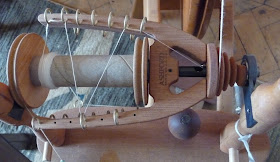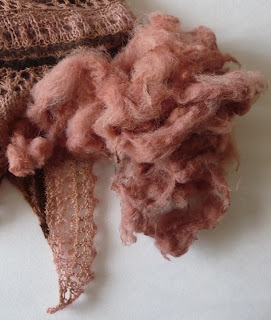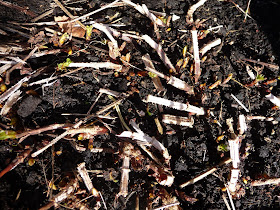Wonderwool Wales is only a matter of weeks away. The moment the doors were opened on the 2015 show, I brutally elbowed off slower moving spinners in my hurry to buy Qaria cashmere from Mandacrafts stall. Recently, I realised that if I didn't pluck up the gumption to spin it soon, it was going to be very hard to justify realising my dreams of a 2016 splurge on qiviut.
Not long after I brought the cashmere home in triumph, my companion, Elinor Gotland, came across the bags while nosing through my stash.
"I'm not being funny, Beaut, but look at the staple length. How can you spin that?"
"Manda advised longdraw."
"Hardly your strong suit. Especially with a maximum 15:1 ratio on your wheel. You'll be pedalling harder than Geraint Thomas up the Pyrenees, to put in enough twist to hold these tiny fibres together."
"Well, I'll just keep it in a bowl to admire while I practice on some short stapled Ryeland. Whatever happens, I'll consider my money well spent, supporting such a worthwhile social enterprise. The least I can do, compared to Manda, she went all the way to Kabul to show the Afghani women how to spin cashmere finely. Look, you can see her in the first picture on this page. How intrepid is that?"
"Mmm. Nice outfit she's got on. Of course," she said, airily, "I have done a bit of spinning in Kabul myself." I turned from the computer screen to look at her, eyes popping. Elinor hurried on. "Oh, it was just a stopover on a long haul flight. I met such handsome, charming Afghani goats, two brothers, Ezat and Nadir. So hospitable, they'd give you the coat off their backs. Literally."
Over the summer, I managed to hide the disappointing yarn I spun longdraw from small rolags of coloured Ryeland. Harder to conceal the hash I made of fitting a fast flyer to an old Ashford Traditional wheel I had refurbished.
"Oh, you've forced it on willy nilly and now the littlest whorl has cracked."
"I know! And I don't understand all the ratios and drive band stuff and I can't get the damn thing to spin right and I think I'll go to bed. OK?"
"Ooo, someone slid down the learning curve." said Elinor. Exit, pursued by a bear.
Giving up on skinny rolags and high wheel ratios, for this Spring's return to the attack, I returned to Roger, my faithful workhorse Ashford Traveller and I did spin two 25g singles of white cashmere by teasing fibres out from the cloud, centimetre by centimetre, and pedalling like the clappers. I cannot pretend this was a wildly rewarding experience. I finished the second at spinning camp, a couple of weeks ago, where a very kind soul allowed me to use her e-spinner, which simply flew, plying those fine singles together with adequate twist. Another spinner tactfully pointed out a fundamental flaw in my plying action and the result was 50g fingering weight cashmere yarn, not as lofty as I'd like, nor as even, but ready to knit.
Recovering from a cold and still feeling grim, regretfully, all I had brought for the rest of the weekend's spinning was another bag of cashmere and some silk. Sampling half a dozen flavours of fruit gin lifted my spirits considerably, as did the fantastic food and good company. Coming to my resue, one spinner lent me her blending board and another just gave me 100g of Down-type wool tops, setting me up for a happy day making pulags, our
name for those fibre sausages, half way between a cotton puni and a hand carded rolag. First, weigh and divide the fibre into 10g portions. Each of mine had 2.5g cashmere, 2.5g silk and 5g wool tops. Laying on the tops and trapping the tips with the flat of the hand, you pull back the bulk of the fibre to stretch out a thin layer on the tines of the carding cloth. Next, a layer of silk went on in
random stripes, then the short stapled cashmere was rubbed acoss the cloth, depositing a haze of fibres with occasional clumps. A flicker is used to smooth the three layers down, its teeth aligned with the tines, rather than locking with them. Building up layers is repetitve, but soothing. Once 10g fibres have been applied, you swing the board round so its short edge faces you, trap the loose ends between two
sticks and roll up, not too tightly, gently lifting the sheet of fibres away from the board by levering up with your thumbs. Slide out one stick, then the other and there is a finished pulag. Immensely satisfying, much admired and compared to silver birch branches, I was still glad to come to the end of my fibre, it having taken best part of the day to complete 21 pulags.

Spinners do like to chortle, even before the fruit gin comes out. This group now has a Ravelry Forum called The Pulag Archipelago. Come and look, better join us soon, before someone implements those suggestions for a stringent entrance exam, as Elinor Gotland has set herself up as team disciplinarian.
Finally, a real beauty shot. Speckled Face Beulah twins, born this morning and already bouncing. The ewe is a first time mum, gave birth with no trouble and must be giving her lambs good energy-packed milk. See how proud she looks? What a girl.
Not long after I brought the cashmere home in triumph, my companion, Elinor Gotland, came across the bags while nosing through my stash.
"I'm not being funny, Beaut, but look at the staple length. How can you spin that?"
"Manda advised longdraw."
"Hardly your strong suit. Especially with a maximum 15:1 ratio on your wheel. You'll be pedalling harder than Geraint Thomas up the Pyrenees, to put in enough twist to hold these tiny fibres together."
"Well, I'll just keep it in a bowl to admire while I practice on some short stapled Ryeland. Whatever happens, I'll consider my money well spent, supporting such a worthwhile social enterprise. The least I can do, compared to Manda, she went all the way to Kabul to show the Afghani women how to spin cashmere finely. Look, you can see her in the first picture on this page. How intrepid is that?"
"Mmm. Nice outfit she's got on. Of course," she said, airily, "I have done a bit of spinning in Kabul myself." I turned from the computer screen to look at her, eyes popping. Elinor hurried on. "Oh, it was just a stopover on a long haul flight. I met such handsome, charming Afghani goats, two brothers, Ezat and Nadir. So hospitable, they'd give you the coat off their backs. Literally."
Over the summer, I managed to hide the disappointing yarn I spun longdraw from small rolags of coloured Ryeland. Harder to conceal the hash I made of fitting a fast flyer to an old Ashford Traditional wheel I had refurbished.
"Oh, you've forced it on willy nilly and now the littlest whorl has cracked."
"I know! And I don't understand all the ratios and drive band stuff and I can't get the damn thing to spin right and I think I'll go to bed. OK?"
"Ooo, someone slid down the learning curve." said Elinor. Exit, pursued by a bear.
Giving up on skinny rolags and high wheel ratios, for this Spring's return to the attack, I returned to Roger, my faithful workhorse Ashford Traveller and I did spin two 25g singles of white cashmere by teasing fibres out from the cloud, centimetre by centimetre, and pedalling like the clappers. I cannot pretend this was a wildly rewarding experience. I finished the second at spinning camp, a couple of weeks ago, where a very kind soul allowed me to use her e-spinner, which simply flew, plying those fine singles together with adequate twist. Another spinner tactfully pointed out a fundamental flaw in my plying action and the result was 50g fingering weight cashmere yarn, not as lofty as I'd like, nor as even, but ready to knit.
Recovering from a cold and still feeling grim, regretfully, all I had brought for the rest of the weekend's spinning was another bag of cashmere and some silk. Sampling half a dozen flavours of fruit gin lifted my spirits considerably, as did the fantastic food and good company. Coming to my resue, one spinner lent me her blending board and another just gave me 100g of Down-type wool tops, setting me up for a happy day making pulags, our
name for those fibre sausages, half way between a cotton puni and a hand carded rolag. First, weigh and divide the fibre into 10g portions. Each of mine had 2.5g cashmere, 2.5g silk and 5g wool tops. Laying on the tops and trapping the tips with the flat of the hand, you pull back the bulk of the fibre to stretch out a thin layer on the tines of the carding cloth. Next, a layer of silk went on in
random stripes, then the short stapled cashmere was rubbed acoss the cloth, depositing a haze of fibres with occasional clumps. A flicker is used to smooth the three layers down, its teeth aligned with the tines, rather than locking with them. Building up layers is repetitve, but soothing. Once 10g fibres have been applied, you swing the board round so its short edge faces you, trap the loose ends between two
sticks and roll up, not too tightly, gently lifting the sheet of fibres away from the board by levering up with your thumbs. Slide out one stick, then the other and there is a finished pulag. Immensely satisfying, much admired and compared to silver birch branches, I was still glad to come to the end of my fibre, it having taken best part of the day to complete 21 pulags.

Spinners do like to chortle, even before the fruit gin comes out. This group now has a Ravelry Forum called The Pulag Archipelago. Come and look, better join us soon, before someone implements those suggestions for a stringent entrance exam, as Elinor Gotland has set herself up as team disciplinarian.
Finally, a real beauty shot. Speckled Face Beulah twins, born this morning and already bouncing. The ewe is a first time mum, gave birth with no trouble and must be giving her lambs good energy-packed milk. See how proud she looks? What a girl.











































